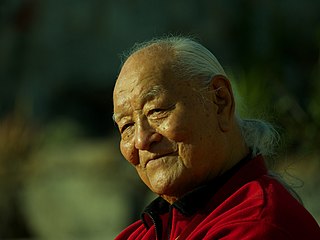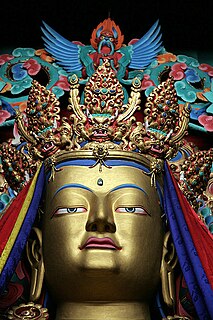
Bon, also spelled Bön, is a Tibetan religious tradition with many similarities to Tibetan Buddhism and also many unique features. Bon, also known as Yungdrung Bon, initially developed in the tenth and eleventh centuries, but may retain elements from earlier religious traditions. Bon remains a significant minority religion in Tibet and the surrounding Himalayan regions.

Mount Kailash, is a 6,638 m (21,778 ft) high peak in the Kailash Range, which forms part of the Transhimalaya in the Ngari Prefecture, Tibet Autonomous Region, China.
Zhangzhung or Shangshung was an ancient culture and kingdom in western and northwestern Tibet, which pre-dates the culture of Tibetan Buddhism in Tibet. Zhangzhung culture is associated with the Bon religion, which in turn, has influenced the philosophies and practices of Tibetan Buddhism. Zhangzhung people are mentioned frequently in ancient Tibetan texts as the original rulers of today's central and western Tibet. Only in the last two decades have archaeologists been given access to do archaeological work in the areas once ruled by the Zhangzhung.
In Tibetan Buddhist tradition, Shambhala is a spiritual kingdom. Shambhala is mentioned in the Kalachakra Tantra. The Bon scriptures speak of a closely related land called Tagzig Olmo Lung Ring.
Terma are various forms of hidden teachings that are key to Vajrayana and Tibetan Buddhist and Bon spiritual traditions. In the Vajrayana Nyingma school tradition, two lineages occur: an oral kama lineage and a revealed terma lineage. Tradition holds that terma teachings were originally esoterically hidden by eighth-century Vajrayana masters Padmasambhava and Yeshe Tsogyal, to be discovered at auspicious times by treasure revealers known as tertöns. As such, terma represent a tradition of continuous revelation in Vajrayana and Tibetan Buddhism.

Lake Manasarovar, also called mTsho Mapham or mTsho Ma-dros-pa locally;, is a high altitude freshwater lake fed by the Kailash Glaciers near Mount Kailash in Burang County, Ngari Prefecture, Tibet Autonomous Region, China. The lake along with Mount Kailash to its north are sacred sites in four religions: Bön, Buddhism, Hinduism and Jainism.

In astronomy, axis mundi is the Latin term for the axis of Earth between the celestial poles.

Namkhai Norbu was a Tibetan Buddhist master of Dzogchen and a professor of Tibetan and Mongolian language and literature at Naples Eastern University. He was a leading authority on Tibetan culture, particularly in the fields of history, literature, traditional religions, and Traditional Tibetan medicine, having written numerous books and scholarly articles on these subjects.

Trul khor, in full tsa lung trul khor, also known as yantra yoga, is a Vajrayana discipline which includes pranayama and body postures (asanas). From the perspective of the Indo-Tibetan Buddhist traditions of Dzogchen, the mind is merely vāyu (breath) in the body. Thus working with vāyu and the body is paramount, while meditation, on the other hand, is considered contrived and conceptual.
Chöd is a spiritual practice found primarily in the Yundrung Bön tradition as well as in the Nyingma and Kagyu schools of Tibetan Buddhism. Also known as "cutting through the ego," the practices are based on the Prajñāpāramitā or "Perfection of Wisdom" sutras, which expound the "emptiness" concept of Buddhist philosophy.

Tonpa Shenrab or Shenrab Miwo —also called the Buddha Shenrab, Guru Shenrab and a number of other titles—is the legendary founder of the Bon tradition of Tibet.
[Shenrab Miwo] occupies a position very similar to that of Śākyamuni in Buddhism, but... we have no available [or pre-10th century] sources with which to establish his historicity, his dates, his racial origin, his activities, and the authenticity of the enormous number of books either attributed directly to him or believed to be his word."

Several cosmological and mythological systems portray four corners of the world or four quarters of the world corresponding approximately to the four points of the compass. At the center may lie a sacred mountain, garden, world tree, or other beginning-point of creation. Often four rivers run to the four corners of the world, and water or irrigate the four quadrants of Earth.
Drenpa Namkha was born in the 8th century near Mount Kailash in Chunlung Ngul Kha in south-western Tibet. As a young student he was a blessed with eight principal Bon teachers. Drenpa Namkha became a self-realized supreme master of the three Bon practices, known as Sutra, Tantra and Dzogchen. Drenpa Namkha is the primary long-life deity according to Bon.
One of the foremost Bonpos of the time, Drenpa Namkha, played an important role during the second persecution of Bon. He headed the Bonpo side in a contest against the Buddhists organized by the king to discover which side had the greatest miraculous power.

Lopön Tenzin Namdak is a Tibetan religious leader and the most senior teacher of Bon, in particular of Dzogchen and the Mother Tantras.

The Gankyil or "wheel of joy" is a symbol and ritual tool used in Tibetan and East Asian Buddhism. It is composed of three swirling and interconnected blades. The traditional spinning direction is clockwise, but the counter-clockwise ones are also common.

Sacred mountains are central to certain religions, and are usually the subjects of many legends. For many, the most symbolic aspect of a mountain is the peak because it is believed that it is closest to heaven or other religious worlds. Many religions have traditions centred on sacred mountains, which either are or were considered holy or are related to famous events. In some cases, the sacred mountain is purely mythical, like the Hara Berezaiti in Zoroastrianism. Mount Kailash is believed to be the abode of the deities Shiva and Parvati, and is considered sacred in four religions: Hinduism, Bon, Buddhism, and Jainism. Volcanoes, such as Mount Etna in Italy, were also considered sacred, Mount Etna being believed to have been the home of Vulcan, the Roman god of fire and the forge.
Kyunglung is a village in the Tibet Autonomous Region of China. Kyunglung Ngüka "Silver Palace of Garuda Valley", located southwest of Mount Kailash, identified with palaces found in the upper Sutlej Valley, was the capital city of the ancient kingdom of Zhangzhung. Many Tibetologists and theorists suggest that Kyunglung may be what the Zhangzhung people called Tagzig Olmo Lung Ring. but some very ancient bonpo scriptures refer to today's Tajikistan, as the Shangshung word Tag-Zig is refer to today's Ta-jik, and istan is the Persian word applied after Islamic rule. As time of 7th century Tibetan king Songsten Gampo, today's Tajik was under Tibetan rule. The Shamgshung emperor was beheaded when he went to war in Amdo. Tajik was part of Shangshung history as the buddha of Bon tradition is believed to have come from there.

Dream yoga or milam —the Yoga of the Dream State—is a suite of advanced tantric sadhana of the entwined Mantrayana lineages of Dzogchen. Dream yoga consists of tantric processes and techniques within the trance Bardos of Dream and Sleep Six Dharmas of Naropa. In the tradition of the tantra, the dream yoga method is usually passed on by a qualified teacher to his/her students after necessary initiation. Various Tibetan lamas are unanimous that it is more of a passing of an enlightened experience rather than any textual information.

The main religion in Tibet has been Buddhism since its outspread in the 8th century AD. The historical region of Tibet is nowadays mostly comprised by the Tibet Autonomous Region of China and partly by the provinces of Qinghai and Sichuan. Before the arrival of Buddhism, the main religion among Tibetans was an indigenous shamanic and animistic religion, Bon, which now comprises a sizeable minority and which would later influence the formation of Tibetan Buddhism.

According to the beliefs of the Nyingma school of Tibetan Buddhism, Beyul are hidden valleys often encompassing hundreds of square kilometers, which Padmasambhava blessed as refuges. Tertöns may reveal them from terma at specific and appropriate times. Their locations were kept on scrolls hidden under rocks and inside caves, monasteries and stupas. They are places where physical and spiritual worlds overlap and Tantric practice effectiveness increases with multiple perception dimensions.














